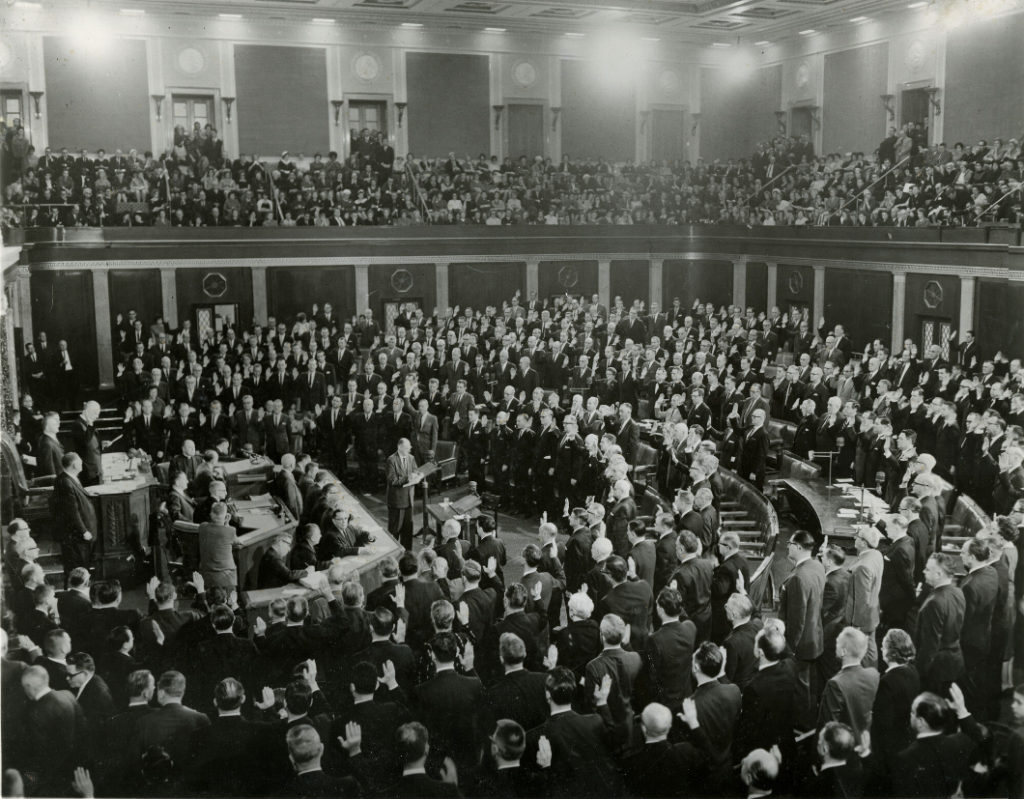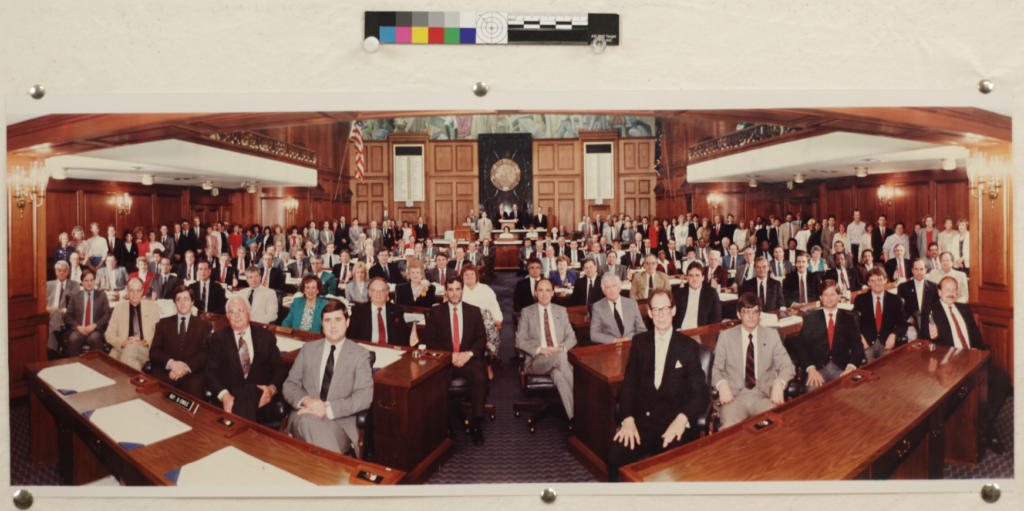
When people think of a rivalry between the members of the Indiana General Assembly, they likely think about the rivalry between Republican and Democrat legislators. And, in today’s world of political polarization, they certainly wouldn’t be wrong. However, there is also a much less publicized rivalry at play in the Indiana General Assembly, which keeps emerging in the interviews for the Indiana Legislative Oral History Initiative (ILOHI): the one between the House and the Senate.
Perhaps the best way to portray this rivalry comes from simply how the two chambers depict each other. This in some ways resembles the way collegial rivals like Indiana University and Purdue University alums would depict each other. When examining how former House members describe the Senate, many colorful descriptions have been used, like “House of Lords” and “Imperial.” Republican Van Smith, who served in the Indiana House of Representatives in 1961, described the Senate as always having “a personal image of being three flights above the House and pictures the House as a bunch of disorganized kids who are irresponsible.” This belief that Senators felt a sense of superiority was also iterated by Democrat Vern Tincher, who served in the Indiana House of Representatives from 1982 to 1994, 1996 to 2002, and from 2004 to 2010, when he stated “The Senate likes to consider themselves the upper chamber and we should listen to their wisdom and advice.” Smith and Tincher paint a picture of a Senate with an ego, but what about the Senators’ impressions of House Representatives?
When interviewing former Senate members, they used words like “zoo” and “rowdies” to describe the House of Representatives. Democrat Lindel Hume, who served in the Indiana House of Representatives from 1974 to 1982 and in the Indiana Senate from 1982 to 2014, stated:
I always liked to say this because I think it pretty much sums it up. The Senate is like a botanical garden and the House is like a Zoo. . . . I went through a period of time, where you didn’t want to go into the House of Representatives if you were a member of the Senate or the public, because first of all it was embarrassing, the things they were doing . . . when you walked out you had pinned on to your coat or taped on your coat “kick me” or you know it was just childish stuff that was going on constantly.
This type of behavior described in the House was also echoed by Republican William Vobach, who served in the Indiana Senate from 1982 to 1990 and described the views of the House during his service as the following: “We always thought that the House was a bunch rowdies having a good time . . . They spent an awful lot of the session having fun and doing stuff where that would not go in the Senate.” From Senators’ perspectives, it seemingly was common to view the House legislators as jocular or unprofessional.

Despite the House and Senate clearly having different work environments and cultures, other factors played into disparities between the legislative bodies. After all, the situation for members serving in the House and Senate are quite a bit different. In fact, Democrat Vi Simpson, who served in the Indiana Senate from 1984 to 2012, felt that another major factor that differentiated the legislative bodies was term limits. She argued, “I do think there is a difference between a body that has a 4-year term and a body that has a 2-year term. The House is always running for reelection . . . There’s no breathing room and I do think that that has an influence on what they do and what they say sometimes.” After all, if you have four years to worry about getting reelected, instead of two, that carries a bit more power, which obviously has the potential to make you feel superior to House members. And of course, from the House perspective, if you have two years only, you may be a bit more attuned to how a Senator may carry themselves, given they have that extra two years and represent a larger portion of the population than you. Even at the federal level the Senate is often considered to be the more prestigious legislative body. As a matter of fact, a 2018 New York Times article utilized a George Washington quote to summarize the power of the Senate to stop potentially bad legislation, where Washington declared “We pour legislation into the Senate saucer to cool it.”[i] Ergo, highlighting this idea of Senate that could interpret as more wise or diligent.
Additionally, Democrat Charlie Brown, who served from 1982 to 2018 in the Indiana House of Representatives and was a member of the Indiana Black Legislative Caucus, pointed out that the number of legislators elected to the House and Senate also made a big difference in terms of why the House and Senate differed. He asserted, “The numbers alone mean that it’s going to be more rancor. Because you’ve got 100 opinions versus 50 . . . And also, the leadership of each chamber, how they rule . . . there are many, many occasions where Democrats in the House could not even get along with or couldn’t get their fellow colleagues, Democrats in the Senate, to agree with them.”

Interestingly, this sort of interparty squabbling was also an issue for Republicans. Republican Ned Lamkin, who served from 1967 to 1982 in the Indiana House of Representatives, stated:
What bothered me a lot was that the House Republicans and the Senate Republicans never talked to each other . . . you could pass a bill in the House that was, you thought, a perfectly good bill and you sent it to have a good sponsor in the Senate and it wouldn’t even be heard. And our positions politically were not exactly meshed, because we never really talked to each other. That really bothered me a whole lot.
When trying to examine the major sources of the tension between the House and Senate, the size of the legislative bodies certainly would make a difference. However, perhaps what is most interesting from both Brown’s and Lamkin’s descriptions is that these differences between the House and Senate caused polarization between members of the same party.
This is fascinating because overall the interparty tension between the House and Senate really does highlight the complexity of our governing system. A similar dynamic played out nationally, when tensions grew between House Republicans and Senate Republicans over the Senate G.O.P.’s deal with Senate Democrats to raise the debt ceiling.[ii] And for months there has been tension between House Democrats and a few Senate Democrats regarding some of President Biden’s legislative objectives.[iii] Therefore, politics is not always about partisan discord, because the differences in the legislative bodies also play a role in the complexity of the legislature as well. As a result, tension in the legislature can take many forms when you have different political parties, organized into different legislative bodies, with people representing different communities. The historic tension between the House and Senate—at both the state and national level— is just one example of that.
[i] Julia Jacobs, Sarah Mervosh, and Matt Stevens, “When the House and the Senate Are Controlled by Different Parties, Who Wins?,” The New York Times, accessed nytimes.com.
[ii] Burgess Everett and Olivia Beavers, “House Republicans Seethe over Senate GOP’s Debt Deal,” POLITICO, accessed politico.com.
[iii] Ron Elving, “Democrats are Having a Unity Problem. That’s Familiar Territory for Them,” NPR, accessed npr.org.
